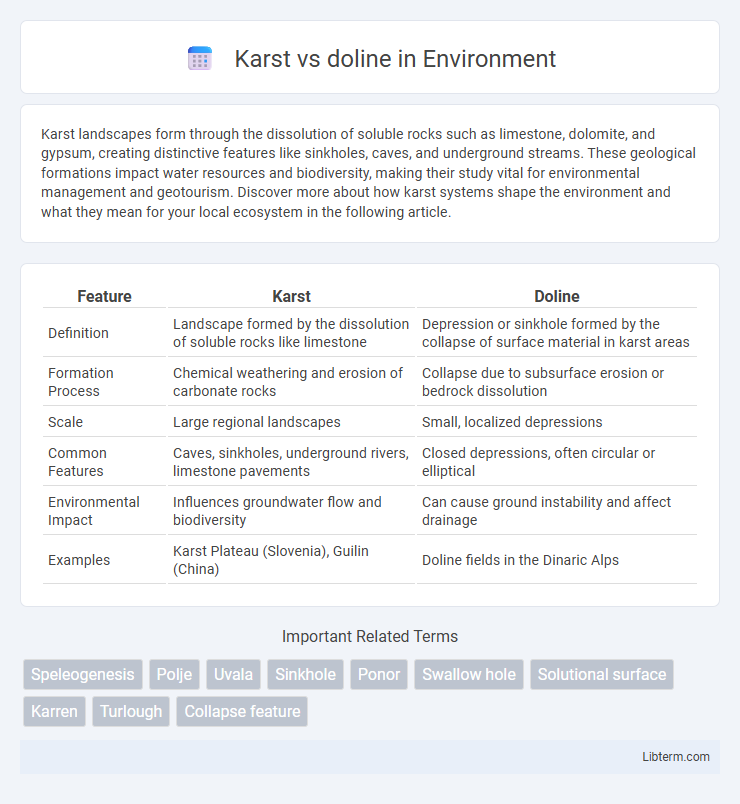Karst landscapes form through the dissolution of soluble rocks such as limestone, dolomite, and gypsum, creating distinctive features like sinkholes, caves, and underground streams. These geological formations impact water resources and biodiversity, making their study vital for environmental management and geotourism. Discover more about how karst systems shape the environment and what they mean for your local ecosystem in the following article.
Table of Comparison
| Feature | Karst | Doline |
|---|---|---|
| Definition | Landscape formed by the dissolution of soluble rocks like limestone | Depression or sinkhole formed by the collapse of surface material in karst areas |
| Formation Process | Chemical weathering and erosion of carbonate rocks | Collapse due to subsurface erosion or bedrock dissolution |
| Scale | Large regional landscapes | Small, localized depressions |
| Common Features | Caves, sinkholes, underground rivers, limestone pavements | Closed depressions, often circular or elliptical |
| Environmental Impact | Influences groundwater flow and biodiversity | Can cause ground instability and affect drainage |
| Examples | Karst Plateau (Slovenia), Guilin (China) | Doline fields in the Dinaric Alps |
Understanding Karst and Doline: Key Definitions
Karst refers to a distinctive landscape formed primarily through the dissolution of soluble rocks such as limestone, characterized by features like sinkholes, caves, and underground drainage systems. A doline, also known as a sinkhole, is a specific type of karst depression formed when the surface collapses into an underlying void or when carbonate rock dissolves, creating a circular or bowl-shaped cavity. Understanding the relationship between karst landscapes and dolines is essential for geological mapping, groundwater management, and hazard assessment in areas underlain by soluble rock strata.
Geological Formation of Karst Landscapes
Karst landscapes form through the dissolution of soluble rocks such as limestone, dolomite, and gypsum, creating distinctive topographies including sinkholes, caves, and underground drainage systems. Dolines, also known as sinkholes, are specific karst features formed by the collapse or subsidence of surface material into voids created by rock dissolution beneath. The geological processes driving karst formation involve chemical weathering, primarily carbonic acid reacting with carbonate rocks, leading to the development of complex subterranean networks characteristic of karst terrain.
How Dolines Develop in Karst Terrains
Dolines develop in karst terrains through the dissolution of soluble rocks like limestone, leading to the formation of closed depressions or sinkholes. These features form as acidic water percolates through fractures, gradually enlarging cavities and causing the overlying surface to collapse or subside. Dolines vary in size and shape, often serving as indicators of active karst processes and subterranean drainage systems.
Main Differences: Karst vs Doline
Karst refers to a distinctive landscape formed by the dissolution of soluble rocks such as limestone, characterized by features like caves, sinkholes, and underground drainage systems. A doline is a specific type of karst depression or sinkhole, typically a bowl-shaped cavity formed by the collapse or dissolution of the surface rock. The main difference lies in scale and classification: karst describes the entire terrain formed by chemical weathering processes, while a doline is a localized landform within that karst system.
Types of Karst Features Beyond Dolines
Karst landscapes exhibit diverse features beyond dolines, including sinkholes, caves, disappearing streams, and limestone pavements, each formed through the dissolution of soluble rocks like limestone, dolomite, and gypsum. Speleothems such as stalactites and stalagmites develop within karst caves, while torrents and poljes represent large enclosed depressions typical in karst regions. These varied formations illustrate the complexity of karst topography driven by chemical weathering and groundwater erosion processes.
Classification of Dolines in Karst Regions
Doline classification in karst regions includes solution dolines formed by the dissolution of soluble rocks, collapse dolines created by the roof collapse of underground cavities, and suffusion dolines caused by the washing away of finer sediments through subsurface drainage. These karst features vary in size and morphology, influencing surface water drainage and landscape development. Understanding doline types aids in predicting groundwater flow and managing karst aquifers.
Environmental Significance of Karst and Dolines
Karst landscapes and dolines play crucial roles in environmental processes by influencing groundwater recharge, filtration, and storage, which supports diverse ecosystems and water supplies. The porous nature of karst formations allows for rapid water infiltration, while dolines act as natural catchment areas, reducing surface runoff and preventing soil erosion. These features contribute significantly to maintaining regional hydrology and biodiversity, making them vital for environmental sustainability and conservation efforts.
Human Impacts on Karst and Doline Systems
Karst and doline systems face significant human impacts including groundwater contamination, land subsidence, and habitat disruption caused by urban development and mining activities. Pollution from agricultural runoff and improperly managed waste infiltrates karst aquifers through dolines, compromising water quality and posing risks to ecosystems and human health. Infrastructure projects on karst terrains increase the likelihood of sinkhole formation, leading to structural damage and economic losses in affected communities.
Famous Karst and Doline Examples Worldwide
The Guangxi Karst in China and the Slovenian Karst region epitomize famous karst landscapes, characterized by limestone plateaus, caves, and sinkholes formed through extensive chemical weathering. The Qattara Depression in Egypt and the Doline in the Western Carpathians, Slovakia showcase notable dolines, which are sinkholes created by the collapse of surface layers over subterranean voids. These natural features are critical for understanding water drainage and landscape evolution in karst environments globally.
Conservation Challenges for Karst and Doline Areas
Karst landscapes and dolines exhibit unique hydrogeological features that contribute to their vulnerability to pollution and habitat disruption, posing significant conservation challenges. Protecting karst aquifers requires controlling surface contamination and managing land use to prevent irreversible damage to underground water systems and delicate cave ecosystems. Doline conservation efforts focus on stabilizing sinkhole formations and preserving native biodiversity, necessitating specialized monitoring and restoration strategies to mitigate erosion and human impact.
Karst Infographic

 libterm.com
libterm.com